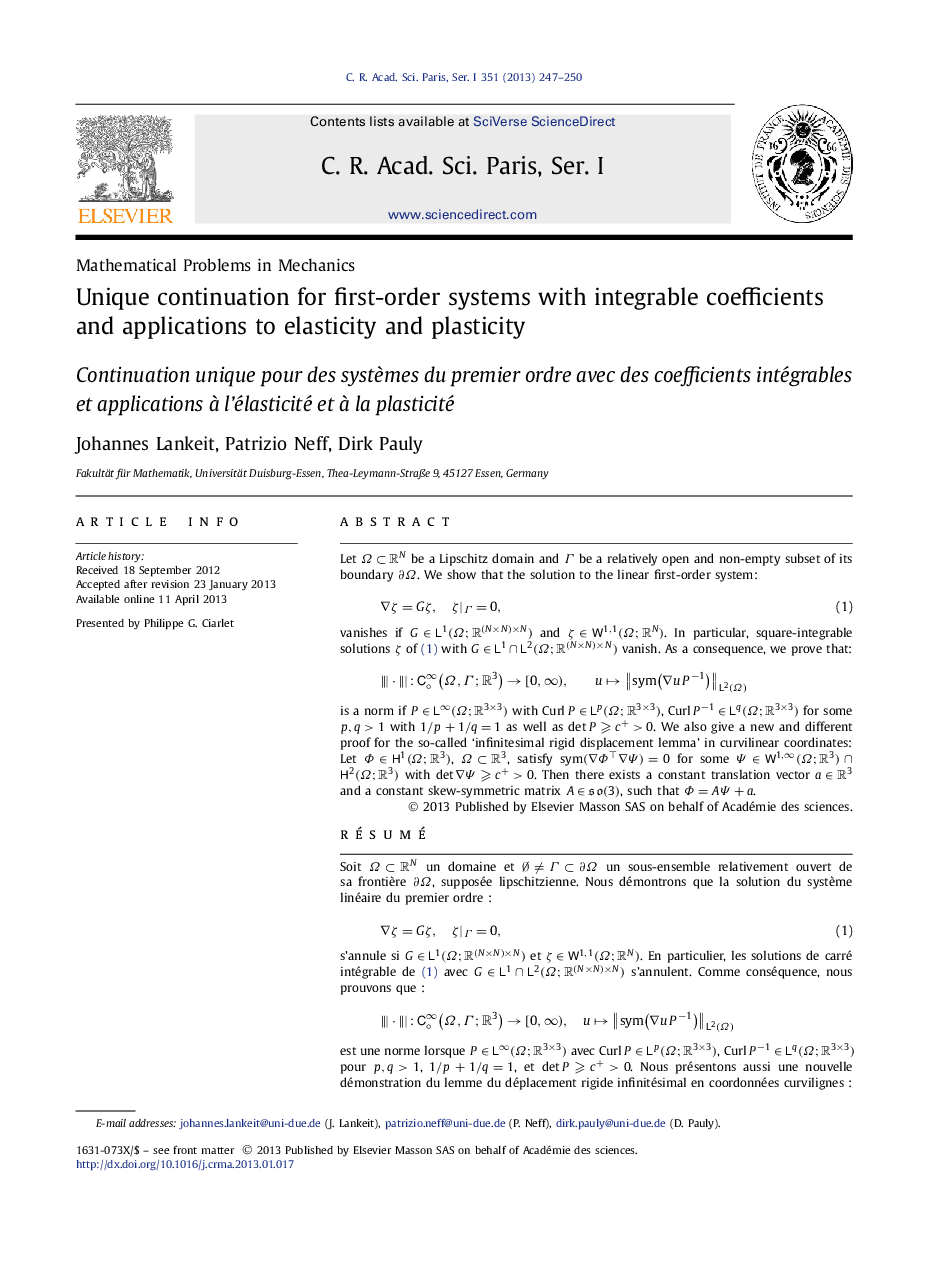| Article ID | Journal | Published Year | Pages | File Type |
|---|---|---|---|---|
| 4670512 | Comptes Rendus Mathematique | 2013 | 4 Pages |
Let Ω⊂RNΩ⊂RN be a Lipschitz domain and Γ be a relatively open and non-empty subset of its boundary ∂Ω. We show that the solution to the linear first-order system:equation(1)∇ζ=Gζ,ζ|Γ=0, vanishes if G∈L1(Ω;R(N×N)×N)G∈L1(Ω;R(N×N)×N) and ζ∈W1,1(Ω;RN)ζ∈W1,1(Ω;RN). In particular, square-integrable solutions ζ of (1) with G∈L1∩L2(Ω;R(N×N)×N)G∈L1∩L2(Ω;R(N×N)×N) vanish. As a consequence, we prove that:⦀⋅⦀:C∘∞(Ω,Γ;R3)→[0,∞),u↦‖sym(∇uP−1)‖L2(Ω) is a norm if P∈L∞(Ω;R3×3)P∈L∞(Ω;R3×3) with CurlP∈Lp(Ω;R3×3), CurlP−1∈Lq(Ω;R3×3) for some p,q>1p,q>1 with 1/p+1/q=11/p+1/q=1 as well as detP⩾c+>0. We also give a new and different proof for the so-called ‘infinitesimal rigid displacement lemma’ in curvilinear coordinates: Let Φ∈H1(Ω;R3)Φ∈H1(Ω;R3), Ω⊂R3Ω⊂R3, satisfy sym(∇Φ⊤∇Ψ)=0sym(∇Φ⊤∇Ψ)=0 for some Ψ∈W1,∞(Ω;R3)∩H2(Ω;R3)Ψ∈W1,∞(Ω;R3)∩H2(Ω;R3) with det∇Ψ⩾c+>0. Then there exists a constant translation vector a∈R3a∈R3 and a constant skew-symmetric matrix A∈so(3)A∈so(3), such that Φ=AΨ+aΦ=AΨ+a.
RésuméSoit Ω⊂RNΩ⊂RN un domaine et ∅≠Γ⊂∂Ω∅≠Γ⊂∂Ω un sous-ensemble relativement ouvert de sa frontière ∂Ω, supposée lipschitzienne. Nous démontrons que la solution du système linéaire du premier ordre :equation(1)∇ζ=Gζ,ζ|Γ=0, sʼannule si G∈L1(Ω;R(N×N)×N)G∈L1(Ω;R(N×N)×N) et ζ∈W1,1(Ω;RN)ζ∈W1,1(Ω;RN). En particulier, les solutions de carré intégrable de (1) avec G∈L1∩L2(Ω;R(N×N)×N)G∈L1∩L2(Ω;R(N×N)×N) sʼannulent. Comme conséquence, nous prouvons que :⦀⋅⦀:C∘∞(Ω,Γ;R3)→[0,∞),u↦‖sym(∇uP−1)‖L2(Ω) est une norme lorsque P∈L∞(Ω;R3×3)P∈L∞(Ω;R3×3) avec CurlP∈Lp(Ω;R3×3), CurlP−1∈Lq(Ω;R3×3) pour p,q>1p,q>1, 1/p+1/q=11/p+1/q=1, et detP⩾c+>0. Nous présentons aussi une nouvelle démonstration du lemme du déplacement rigide infinitésimal en coordonnées curvilignes : si Φ∈H1(Ω;R3)Φ∈H1(Ω;R3) satisfait sym(∇Φ⊤∇Ψ)=0sym(∇Φ⊤∇Ψ)=0 pour certain Ψ∈W1,∞(Ω;R3)∩H2(Ω;R3)Ψ∈W1,∞(Ω;R3)∩H2(Ω;R3), avec det∇Ψ⩾c+>0, il existe des constantes a∈R3a∈R3 et A∈so(3)A∈so(3) telles que Φ=AΨ+aΦ=AΨ+a.
